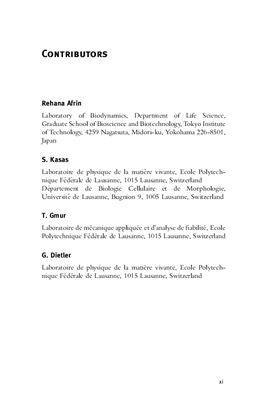Elsevier Science, 2007, 278 Pages
By using nanotechnological methods, we can now poke around protein molecules, genes, membranes, cells and more. Observation of such entities through optical and electron microscopes tempt us to touch and manipulate them. It is now possible to do so, and scientists around the world have started pulling, pushing and cutting small structures at the base of life processes to understand the effect of our hand work.
The book describes the physical properties of such life supporting structures from the molecular level with a special emphasis on their designs based on the mechanical strength and flexibility, membrane and other biological nanostructures.
Describes the basic mechanical features of proteins, DNA, cell membrane and other biological nanostructures
Explains the basic concepts and mathematics of elementary mechanics needed to understand and perform experimental work.
Nano-biomechanics, the title field of this book, is currently emerging as a new and attractive area of scientific research bridging biological and mechanical sciences at the molecular level. Biomechanics without the prefix of nano has been a quite active field dealing mainly with macroscopic bodily movements and especially with the dynamics of blood flow. In nano-biomechanics, a variety of newly developed devices with the capability of observing and manipulating individual atoms and molecules are
ambitiously applied to elucidate the principles of life supporting molecular interactions.
By using nanotechnological methods, we can now poke around protein molecules, genes, membranes, cells and more. Observation of such entities through optical and electron microscopes tempt us to touch and manipulate them. It is now possible to do so, and scientists around the world have started pulling, pushing and cutting small structures at the base of life processes to understand the effect of our hand work.
The book describes the physical properties of such life supporting structures from the molecular level with a special emphasis on their designs based on the mechanical strength and flexibility, membrane and other biological nanostructures.
Describes the basic mechanical features of proteins, DNA, cell membrane and other biological nanostructures
Explains the basic concepts and mathematics of elementary mechanics needed to understand and perform experimental work.
Nano-biomechanics, the title field of this book, is currently emerging as a new and attractive area of scientific research bridging biological and mechanical sciences at the molecular level. Biomechanics without the prefix of nano has been a quite active field dealing mainly with macroscopic bodily movements and especially with the dynamics of blood flow. In nano-biomechanics, a variety of newly developed devices with the capability of observing and manipulating individual atoms and molecules are
ambitiously applied to elucidate the principles of life supporting molecular interactions.

